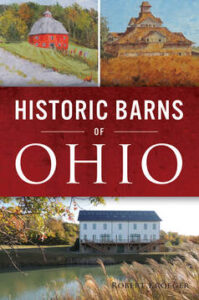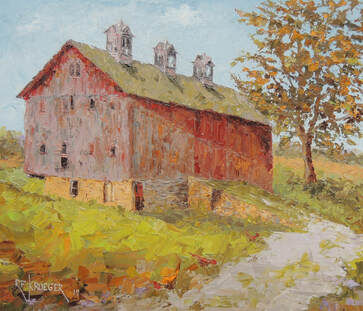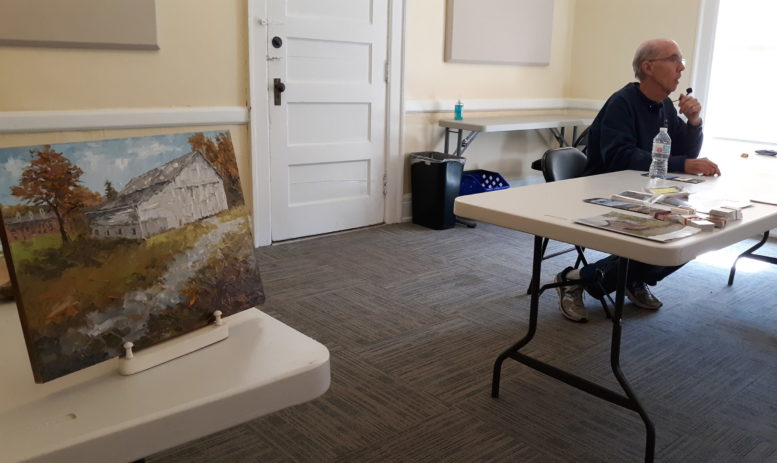By JAN LARSON McLAUGHLIN
BG Independent News
It was a sad sagging barn in Licking County that inspired Dr. Robert Kroeger to find historic barns in Ohio and paint pictures that will live on long after they are gone.
Since then, Kroeger has traveled to Ohio’s 88 counties to find and paint once grand barns. Earlier this month, he was at the Wood County Museum to paint a barn and share stories of his travels.
“Barns represent the heart of America, and the old ones are bleeding. So many barns, so little time,” Kroeger said about his effort to preserve them on canvas.
“My suburbanite friends think I’m strange for doing this,” he told an audience at the museum. “But 50 to 100 years from now, when people look at these paintings, they will see the sacrifices made to build them.”

His book, “Historic Barns of Ohio,” features aging structures and their storied beginnings. The old barns are fading fast – and will never be replaced with the workmanship it took to build them centuries ago.
Kroeger’s had nothing more than a passing interest in old barns until the early 2000s, when he and his wife were staying in a rural bed and breakfast in Licking County.
While driving down a country road, they came upon a deteriorating barn, which he dubbed “Granville Gray.”
“The roof was sagging, boards were missing, and it was tilted at least 10 degrees,” Kroeger said. “It was like a message came right at me.”
He knocked on the door of a nearby farmhouse – beginning his new venture of knocking on strangers’ doors and trespassing on farmland – if necessary.

The old barn was the start of his Ohio Barn Project, which has taken Kroeger across the state, where he’s painted barns, talked with owners, and written stories about each structure.
But first, Kroeger had to take lessons on how to paint using oil with palette knives, producing a thick texture, called impasto. The paintings are framed in old barn siding, sometimes from the barn pictured.
“They were pretty ugly. No, they were really ugly,” Kroeger said of his first painting attempts.
Once he had fine-tuned his artistic skills, he went in search of old barns. After being greeted by a landowner with a beard down to his waist, where his rifle sat, Kroeger began working with “barn scouts,” who he enlisted to help him find barns and the owners that could allow him access.
All across Ohio, his search turned up barns built as far back as the Revolutionary War era. The oldest farm was 500 acres in the hills of Adams County, given to Alexander Smiley by King George III in 1772. The farm is now owned by the ninth generation of the family.
“The barn was way up on a hill. It was hard to find,” Kroeger recalled.

In Monroe County, Kroeger discovered a barn built in the 1850s by German stonemasons.
“Every Ohioan should go to Monroe County,” he said. “There’s no flatness in Monroe County. There’s no straight road.”
The stonemasons used huge blocks of sandstone that still stand strong today. “It’s an amazing barn,” he said.
Many of Kroeger’s stories stray from the barns themselves into the lives of those who had the ingenuity and money to build them.
In Trumbull County, sits a barn with a slate roof – even the silo has a hexagonal slate roof, he said. In 1898, the farmer disappeared without a trace. A year later, his wife got a letter from him that he had been lured away to the Klondike by the gold rush. Apparently, the marriage was less than amicable, Kroeger said.
In Hamilton County is a barn built in 1751, by a former preacher who had been tarred and feathered for his profession. The defrocked preacher went on to try farming instead, leaving a barn that still stands today.

Kroeger is now working on a second book devoted to round barns.
In Champaign County, a beautiful orange brick barn – with a huge observatory on top – was built in 1861 and is now an historic landmark.
“It’s a wonderful, wonderful barn,” Kroeger said.
The site was a land speculation farm in the 1700s called Nutwood Place. Back then, “you could mark your land with an ‘X’ on trees,” Kroeger said. But because the owner was illiterate, he ended up losing the land.
Later, a commercial hatter bought the land and built the round brick barn, with a spiral staircase to the observatory, where he could watch his race horses.
Another round barn survives in Fairfield County, where a soldier from the Revolutionary War and the War of 1812 built a magnificent structure.
“They were not engineers, but they could build a barn still standing 200 years later,” Kroeger said.
The farm representing Wood County is located on Jerry City Road. The barn has three cupolas that can be seen from a distance.

“They are probably the most ornate cupolas I’ve ever seen: a five-pointed roof – covered in octagonal slate – two portholes, and eight louvered windows. I can visualize the architect designing them in 1896, a date that still survives in the barn, and deciding to leave his artistic mark,” Kroeger said. “He did.”
As Kroeger does when he comes across remarkable historic barns, he started knocking on doors of neighboring houses on Jerry City Road. The son of the current owners took him on a tour of the barn, and gave Kroeger siding to create a frame for the painting.
The large Pennsylvania-style bank barn with forebay, was built with saw-cut timber, confirming the construction date of 1896. The structure has been well preserved, still hinting that the original farmer was prosperous enough to hire a skilled architect and an equally talented barn builder, Kroeger said. Even though some of the limestone support for the bank has crumbled, the weathered red paint is fading, and boards in the windows are missing, the glory of this old barn shines on, thanks to its three cupolas, Kroeger wrote.
Kroeger has donated most of his barn paintings to be used for fundraisers for non-profit organizations. Last week, he donated the demonstration painting of the old Wood County Infirmary Cattle Barn to be raffled off.


